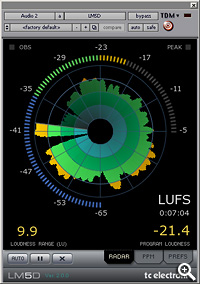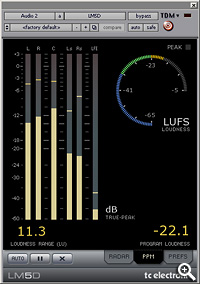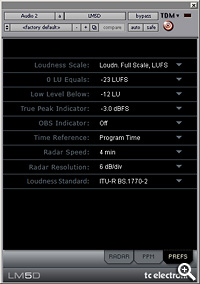Details
 Previous level control methods are responsible for unacceptable level jumps in television, for music CDs getting increasingly distorted, and for different audio formats and program genres becoming incompatible: Pristine music tracks from the past don’t co-exist with new recordings, TV commercials don’t fit drama, classical music or film and broadcast doesn’t match. The most fundamental audio issue of all - control of loudness - every day makes millions of people adjust the volume control over and over again.
Previous level control methods are responsible for unacceptable level jumps in television, for music CDs getting increasingly distorted, and for different audio formats and program genres becoming incompatible: Pristine music tracks from the past don’t co-exist with new recordings, TV commercials don’t fit drama, classical music or film and broadcast doesn’t match. The most fundamental audio issue of all - control of loudness - every day makes millions of people adjust the volume control over and over again.
Compliant with ITU-R BS.1770-2, LM5D offers a standardized and intuitively correct step forward. These loudness radar meters may be used for precise balancing and tight specification of any type of audio signal, and cover mono, stereo and 5.1 formats.
In a multi-platform world, it is also important that delivery criteria can be easily specified and met even by people not primarily concerned with audio. LM5D empowers the production engineer/musician/journalist to visualize the loudness tolerance of the consumer under different listening conditions. With standardized loudness control in place in the studio, less level correction is needed downstream, with better audio quality the result. For platforms where range restriction is needed, audio results are also improved because foreground and background elements of a mix automatically retains their relative position. LM5D consequently enables easy level management across distribution and broadcast platforms without the need for extensive metadata maintenance.
 LM5D displays real-time Loudness (LU or LUFS) and True-peak level along with Loudness History (1 minute to 24 hours) in the Radar View. The angular, color-coded display makes it easy for an editor to balance audio visually, and to see when level falls below or exceeds the end-listener's Loudness Range Tolerance. The True-peak level display warns the operator when excessive level is at the risk of creating distortion in downstream equipment such as data reduction codecs or converters.
LM5D displays real-time Loudness (LU or LUFS) and True-peak level along with Loudness History (1 minute to 24 hours) in the Radar View. The angular, color-coded display makes it easy for an editor to balance audio visually, and to see when level falls below or exceeds the end-listener's Loudness Range Tolerance. The True-peak level display warns the operator when excessive level is at the risk of creating distortion in downstream equipment such as data reduction codecs or converters.
Furthermore, LM5D adds two Universal Descriptors, by which the entire loudness "landscape" of a program, film or music track may be precisely characterized. LM5D improves audio quality and reduces level jumps on all distribution platforms from Mobile TV and iPod to HDTV using AAC or Dolby AC3, and work coherently together with TC equipment - as well as equipment of other brands adhering to the BS.1770-2 standard. More details may be found in the Tech Library.
 Note: In the latest version of Dolby's LM100 meter, it has become BS.1770 compliant. It's descriptor, "Dialnorm", therefore also now complies with Center of Gravity in LM5D. Be sure to engage "All Sources", "All Channels" on LM100 to comply with BS.1770, and when comparing results between LM5D and LM100.
Note: In the latest version of Dolby's LM100 meter, it has become BS.1770 compliant. It's descriptor, "Dialnorm", therefore also now complies with Center of Gravity in LM5D. Be sure to engage "All Sources", "All Channels" on LM100 to comply with BS.1770, and when comparing results between LM5D and LM100.
|
|
|
 |
 |
|
Submit the form below to get notified with the latest exciting Product News and Great Competitions
Please fill out the fields marked in red
|
Radar Loudness Meter for Native DAWs
LM6 Radar Loudness Meter gives you direct access to our revolutionary meter whether you are using Media Composer, Final Cut Pro X, Pro Tools, Logic Pro, Nuendo, Wavelab, Sequoia, etc. on a Mac or PC and whether your productions are in mono, stereo or 5.1.
|

Click here to find a TC Electronic dealer near you |
PowerCore 4.3.3 for PC and 4.3.3 or MAC
TC Electronic has released PowerCore 4.3.3. Version 4.3.3 improves performance and stability
|
DJ Greg Stainer
Most residents of Dubai know of DJ Greg Stainer from Radio 1 UAE and many more know of him as resident DJ at Zinc, the nightclub at Crowne Plaza Hotel. An important part of his hardware arsenal is the TC Electronic Konnekt 24D, a firewire audio interface with built-in DSP effects.
|
|



